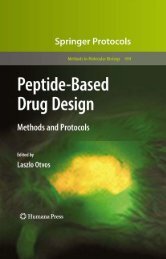You also want an ePaper? Increase the reach of your titles
YUMPU automatically turns print PDFs into web optimized ePapers that Google loves.
214 Singer and Hoffmann<br />
3. Methods<br />
There are two general strategies to synthesize phosphopeptides by Fmoc<br />
chemistry. First, the postsynthetic global phosphorylation approach (7,9) incorporates<br />
an Fmoc-protected Ser, Thr, or Tyr without side-chain protection. An<br />
obvious advantage of this approach is that both the unmodified and phosphorylated<br />
peptides can be obtained from a single synthesis by splitting the resin<br />
after the peptide synthesis prior to phosphorylation. The second approach<br />
incorporates phosphorylated Fmoc amino acid derivatives carrying TFA-labile<br />
protecting groups in the side chain, referred to as the building block strategy.<br />
Both methods have inherent advantages and disadvantages, but usually work<br />
well for singly phosphorylated peptides up to 20 residues in length. For longer<br />
or multiply phosphorylated peptides, the appropriate strategy has to be selected<br />
depending on the peptide sequence and the number of residues to be phosphorylated.<br />
Moreover, it might be necessary in some cases to optimize the heredescribed<br />
standard protocols for “difficult” sequences by using longer reaction<br />
times or a higher reagent excess. Alternatively, the purification strategy has to<br />
be optimized to separate the desired phosphopeptide from by-products.<br />
For the synthesis of monophosphorylated peptides with “easy-to-synthesize”<br />
sequences containing no bulky side chains or protecting groups proximal to the<br />
phosphorylation site, the direct incorporation of monobenzyl protected phosphoserine<br />
(10), phosphothreonine (6), and phosphotyrosine (4) is usually preferred,<br />
as standard peptide synthesis reagents are used and no additional postsynthetic<br />
handling steps are required (see Note 12). For multiply phosphorylated peptides<br />
and especially for proximal phosphorylation sites, we prefer the global phosphorylation<br />
approach. This strategy is also more efficient and cost saving if several<br />
phosphopeptides or the corresponding unmodified peptides are synthesized, for<br />
example, in a parallel peptide synthesis.<br />
3.1. Multiple Solid Phase <strong>Peptide</strong> Synthesis<br />
1. Swell the resin in DMF for 30 min (e.g., 40 mg Rink-amide MBHA resin,<br />
25 �mol amino groups).<br />
2. Add 1 mL piperidine (40% by vol. in DMF) and discard after 3 min.<br />
3. Add 1 mL piperidine (20% by vol. in DMF) for 10 min and remove.<br />
4. Wash the resin six times with 1 mL DMF for 1 min each.<br />
5. Prepare a solution of 0.5 M HOBt in DMF or in a mixture of NMP and DMF (1:1<br />
by vol.).<br />
6. Dissolve the desired amount of the Fmoc amino acids in the HOBt-solution to a<br />
final concentration of 0.5 M (see Note 13).<br />
7. Add the amino acid solution from step 6 at a 4- to 10-fold molar excess over<br />
the amino groups of the resin (e.g., 200 �mol [8 eq] amino acid derivative corresponding<br />
to 400 �L Fmoc amino acid solution).






